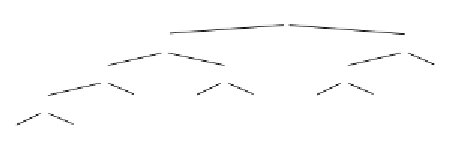Java Reference
In-Depth Information
figure 7.7
A trace of the
recursive calculation
of the Fibonacci
numbers
F5
F4
F3
F3
F2
F2
F1
F2
F1
F1
F0
F1
F0
F1
F0
The underlying problem is that this recursive routine performs redundant
calculations. To compute
fib(n)
, we recursively compute
fib(n-1)
. When the
recursive call returns, we compute
fib(n-2)
by using another recursive call.
But we have already computed
fib(n-2)
in the process of computing
fib(n-1)
,
so the call to
fib(n-2)
is a wasted, redundant calculation. In effect, we make
two calls to
fib(n-2)
instead of only one.
Normally, making two method calls instead of one would only double
the running time of a program. However, here it is worse than that: Each call to
fib(n-1)
and each call to
fib(n-2)
makes a call to
fib(n-3)
; thus there are actu-
ally three calls to
fib(n-3)
. In fact, it keeps getting worse: Each call to
fib(n-2)
or
fib(n-3)
results in a call to
fib(n-4)
, so there are five calls to
fib(n-4)
. Thus we
get a compounding effect: Each recursive call does more and more redundant
work.
Let
C
(
N
) be the number of calls to
fib
made during the evaluation of
fib(n)
.
Clearly
C
(0) =
C
(1) = 1 call. For
N
The recursive
routine
fib
is
exponential.
2, we call
fib(n)
, plus all the calls needed to
evaluate
fib(n-1)
and
fib(n-2)
recursively and independently. Thus
. By induction, we can easily verify that for
≥
CN
()
=
CN
1
(
-
)
+
CN
2
(
-
)
+
1
N
3 the solution to this recurrence is
C
(
N
) =
F
N
+ 2
+
F
N
- 1
- 1. Thus the number
of recursive calls is larger than the Fibonacci number we are trying to compute,
and it is exponential. For
N
= 40,
F
40
= 102,334,155, and the total number of
recursive calls is more than 300,000,000. No wonder the program takes forever.
The explosive growth of the number of recursive calls is illustrated in Figure 7.7.
≥
This example illustrates the fourth and final basic rule of recursion.
The fourth funda-
mental rule of
recursion: Never
duplicate work by
solving the same
instance of a prob-
lem in separate
recursive calls.
4.
Compound interest rule:
Never duplicate work by solving the same
instance of a problem in separate recursive calls.
7.3.5
preview of trees
The
tree
is a fundamental structure in computer science. Almost all operating
systems store files in trees or tree-like structures. Trees are also used in com-
piler design, text processing, and searching algorithms. We discuss trees in
detail in Chapters 18 and 19. We also make use of trees in Sections 11.2.4
(expression trees) and 12.1 (Huffman codes).
One definition of the tree is recursive: Either a tree is empty or it consists
of a root and zero or more nonempty subtrees
T
1
T
2
,
,
…
,
T
k
,
each of whose





Search WWH ::

Custom Search